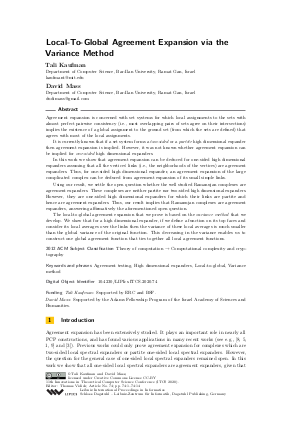Local-To-Global Agreement Expansion via the Variance Method
Authors Tali Kaufman, David Mass
-
Part of:
Volume:
11th Innovations in Theoretical Computer Science Conference (ITCS 2020)
Part of: Series: Leibniz International Proceedings in Informatics (LIPIcs)
Part of: Conference: Innovations in Theoretical Computer Science Conference (ITCS) - License:
 Creative Commons Attribution 3.0 Unported license
Creative Commons Attribution 3.0 Unported license
- Publication Date: 2020-01-06
File

PDF
LIPIcs.ITCS.2020.74.pdf
- Filesize: 469 kB
- 14 pages
Document Identifiers
Subject Classification
ACM Subject Classification
- Theory of computation → Computational complexity and cryptography
Keywords
- Agreement testing
- High dimensional expanders
- Local-to-global
- Variance method
Metrics
- Access Statistics
-
Total Accesses (updated on a weekly basis)
0PDF Downloads0Metadata Views
Abstract
Agreement expansion is concerned with set systems for which local assignments to the sets with almost perfect pairwise consistency (i.e., most overlapping pairs of sets agree on their intersections) implies the existence of a global assignment to the ground set (from which the sets are defined) that agrees with most of the local assignments. It is currently known that if a set system forms a two-sided or a partite high dimensional expander then agreement expansion is implied. However, it was not known whether agreement expansion can be implied for one-sided high dimensional expanders. In this work we show that agreement expansion can be deduced for one-sided high dimensional expanders assuming that all the vertices' links (i.e., the neighborhoods of the vertices) are agreement expanders. Thus, for one-sided high dimensional expander, an agreement expansion of the large complicated complex can be deduced from agreement expansion of its small simple links. Using our result, we settle the open question whether the well studied Ramanujan complexes are agreement expanders. These complexes are neither partite nor two-sided high dimensional expanders. However, they are one-sided high dimensional expanders for which their links are partite and hence are agreement expanders. Thus, our result implies that Ramanujan complexes are agreement expanders, answering affirmatively the aforementioned open question. The local-to-global agreement expansion that we prove is based on the variance method that we develop. We show that for a high dimensional expander, if we define a function on its top faces and consider its local averages over the links then the variance of these local averages is much smaller than the global variance of the original function. This decreasing in the variance enables us to construct one global agreement function that ties together all local agreement functions.
Cite As Get BibTex
Tali Kaufman and David Mass. Local-To-Global Agreement Expansion via the Variance Method. In 11th Innovations in Theoretical Computer Science Conference (ITCS 2020). Leibniz International Proceedings in Informatics (LIPIcs), Volume 151, pp. 74:1-74:14, Schloss Dagstuhl – Leibniz-Zentrum für Informatik (2020)
https://doi.org/10.4230/LIPIcs.ITCS.2020.74
BibTex
@InProceedings{kaufman_et_al:LIPIcs.ITCS.2020.74,
author = {Kaufman, Tali and Mass, David},
title = {{Local-To-Global Agreement Expansion via the Variance Method}},
booktitle = {11th Innovations in Theoretical Computer Science Conference (ITCS 2020)},
pages = {74:1--74:14},
series = {Leibniz International Proceedings in Informatics (LIPIcs)},
ISBN = {978-3-95977-134-4},
ISSN = {1868-8969},
year = {2020},
volume = {151},
editor = {Vidick, Thomas},
publisher = {Schloss Dagstuhl -- Leibniz-Zentrum f{\"u}r Informatik},
address = {Dagstuhl, Germany},
URL = {https://drops.dagstuhl.de/entities/document/10.4230/LIPIcs.ITCS.2020.74},
URN = {urn:nbn:de:0030-drops-117597},
doi = {10.4230/LIPIcs.ITCS.2020.74},
annote = {Keywords: Agreement testing, High dimensional expanders, Local-to-global, Variance method}
}
Author Details
Funding
- Kaufman, Tali: Supported by ERC and BSF.
- Mass, David: Supported by the Adams Fellowship Program of the Israel Academy of Sciences and Humanities.
References
-
Boaz Barak, Pravesh K. Kothari, and David Steurer. Small-Set Expansion in Shortcode Graph and the 2-to-2 Conjecture. In 10th Innovations in Theoretical Computer Science Conference, ITCS 2019, January 10-12, 2019, San Diego, California, USA, pages 9:1-9:12, 2019.

-
Yotam Dikstein and Irit Dinur. Agreement testing theorems on layered set systems. In Proceedings of the 60th Annual Symposium on Foundations of Computer Science (FOCS), 2019.

-
Irit Dinur, Yuval Filmus, and Prahladh Harsha. Analyzing Boolean functions on the biased hypercube via higher-dimensional agreement tests. In Proceedings of the Thirtieth Annual ACM-SIAM Symposium on Discrete Algorithms (SODA), pages 2124-2133, 2019.

-
Irit Dinur and Tali Kaufman. High dimensional expanders imply agreement expanders. In 2017 IEEE 58th Annual Symposium on Foundations of Computer Science (FOCS), pages 974-985, 2017.

-
Irit Dinur, Subhash Khot, Guy Kindler, Dor Minzer, and Muli Safra. Towards a proof of the 2-to-1 games conjecture? In Proceedings of the 50th Annual ACM SIGACT Symposium on Theory of Computing (STOC), pages 376-389, 2018.

-
Irit Dinur and David Steurer. Direct product testing. In 2014 IEEE 29th Conference on Computational Complexity (CCC), pages 188-196, 2014.

-
S. Evra and T. Kaufman. Bounded degree cosystolic expanders of every dimension. In Proceedings of the 48th Annual ACM SIGACT Symposium on Theory of Computing, STOC 2016, Cambridge, MA, USA, June 18-21, 2016, pages 36-48, 2016.

-
Subhash Khot, Dor Minzer, and Muli Safra. On independent sets, 2-to-2 games, and Grassmann graphs. In Proceedings of the 49th Annual ACM SIGACT Symposium on Theory of Computing (STOC), pages 576-589, 2017.

-
Subhash Khot, Dor Minzer, and Muli Safra. Pseudorandom sets in grassmann graph have near-perfect expansion. In 2018 IEEE 59th Annual Symposium on Foundations of Computer Science (FOCS), pages 592-601, 2018.

- A. Lubotzky. High Dimensional Expanders. arXiv, 2017. URL: http://arxiv.org/abs/1712.02526.
-
A. Lubotzky, R. Phillips, and P. Sarnak. Ramanujan graphs. Combinatorica, 8(3):261-277, 1988.

-
A. Lubotzky, B. Samuels, and U. Vishne. Explicit constructions of Ramanujan complexes of type Ã_d. European Journal of Combinatorics, 26(6):965-993, 2005.

